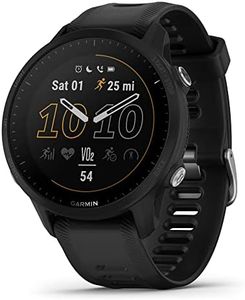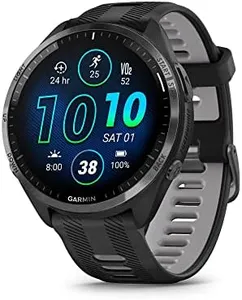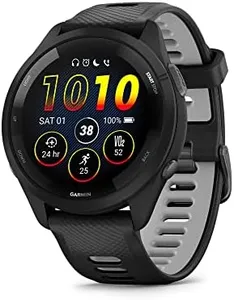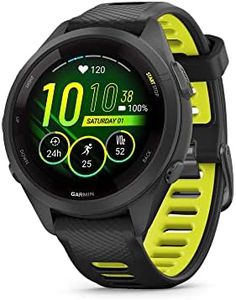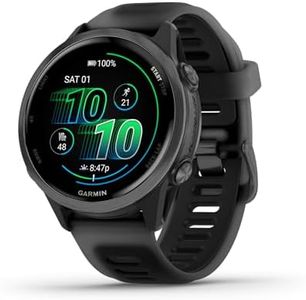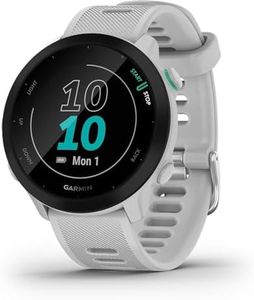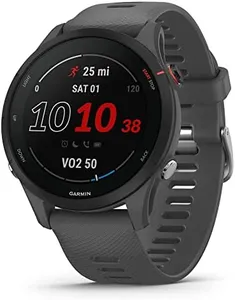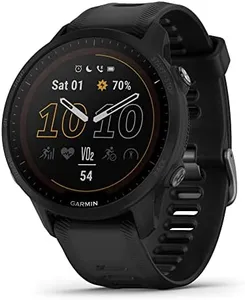We Use CookiesWe use cookies to enhance the security, performance,
functionality and for analytical and promotional activities. By continuing to browse this site you
are agreeing to our privacy policy
8 Best Garmin Forerunners
From leading brands and best sellers available on the web.Buying Guide for the Best Garmin Forerunners
When you're looking to buy a Garmin Forerunner, your main goal is likely to track your fitness, runs, or overall health more effectively. It's important to remember that the right device for you is the one that best matches your needs, whether you're a casual runner, a marathon enthusiast, or someone looking to keep better tabs on your daily activity and heart health. By understanding the main features and how they apply to your lifestyle, you'll make a choice that keeps you motivated and helps you get the most from your workouts.GPS and AccuracyGPS tells your watch where you are and how far and fast you've run, which is crucial for runners who want accurate tracking of their workouts and routes. Watches vary in how quickly they pick up a signal and how well they perform under trees or in cities with tall buildings. Basic models often have standard GPS, good for open spaces and straightforward tracking, while more advanced watches may include multi-satellite support (GNSS), offering even better accuracy in tricky environments. If you mostly run on city streets or parks, a basic GPS may suffice, but for trail runners or those training in dense urban areas, enhanced accuracy will be worth it.
Heart Rate MonitoringHeart rate monitoring lets you see how hard your body is working during exercise and helps you train smarter by staying in the right effort zones. Some watches offer simple wrist-based heart rate sensors, while higher-end models have improved algorithms and can even broadcast your heart rate to other devices. If you just want to keep an eye on your heart rate or use it to pace yourself, the basic version is fine. More dedicated athletes who rely on heart rate for interval training or need high accuracy for advanced features should look for models with advanced sensors or compatibility with chest straps.
Battery LifeBattery life determines how long your watch can run before needing a recharge, which is important if you do long runs, go on multi-day trips, or simply want hassle-free daily use. Less expensive watches might last a few days with normal use or 10-12 hours with GPS active; more advanced models can last longer, sometimes even weeks in basic mode or 20+ hours in GPS mode. Consider how often you want to charge your watch and what your longest activities look like—if you’re a marathon runner or hiker, long battery is key, whereas daily joggers may not need as much endurance.
Training and Performance FeaturesThese features analyze your data to give guidance on training load, recovery, VO2 max, and even suggest workouts. Simpler models keep it basic, tracking runs, pace, and some recovery tips. Mid- and high-end models can track multiple sports, analyze running form, give detailed feedback, and help you set or reach specific fitness goals. If you just want your runs tracked, basic features will do, but if you want deeper training insights or multi-sport tracking, look for more advanced offerings.
Display and UsabilityDisplay size, clarity, and how you interact with the watch (buttons vs. touchscreen) affect how easy it is to see your stats on the move and adjust settings. Entry-level watches often have smaller, simpler displays and button controls, which are easier to use with sweaty hands or in the rain. More premium models bring larger, brighter screens, color displays, and sometimes touch capability for navigating menus more intuitively. If you run in bright sunlight, look for a high-contrast screen. For those who value quick navigation or have trouble with small screens, bigger, clearer displays offer an advantage.
Smartwatch FeaturesBeyond sports, some Forerunners offer smart features like notifications, music storage, contactless payments, and basic apps. Basic models might just show call and text alerts, while pricier versions can hold music or enable you to leave your phone at home during workouts. If you want your watch to double as a daily smartwatch, handle notifications, or play music, focus on those features; otherwise, sticking to fitness essentials might keep things simpler and lighter.
Water ResistanceWater resistance refers to whether you can take your watch in the rain, shower, or even swimming. Most Forerunners handle sweat and rain, but swimming support varies; some track pool or open water swims, others do not. If you only run, basic water resistance is enough, but if you swim or train in the rain a lot, make sure your watch is rated for those activities.
